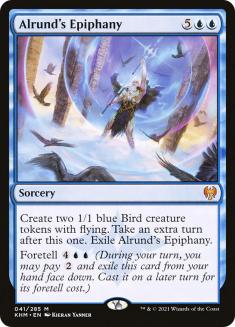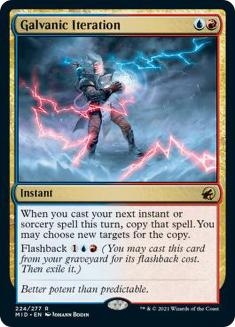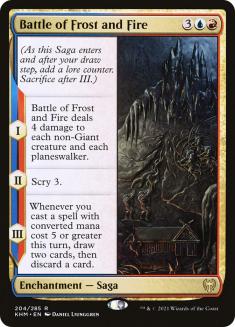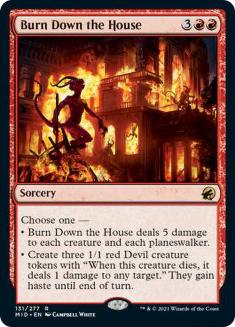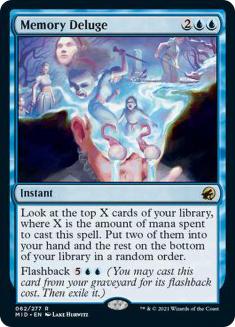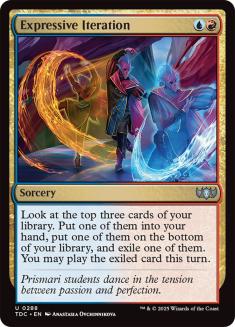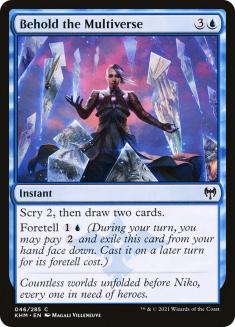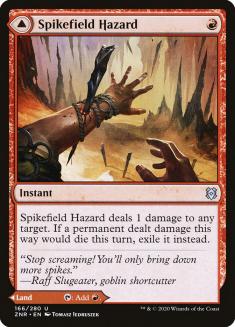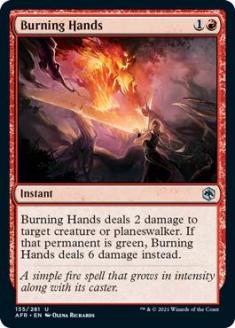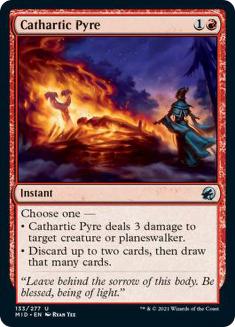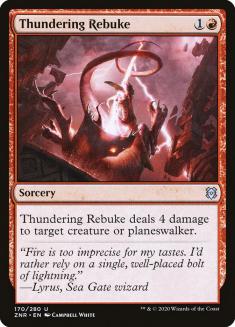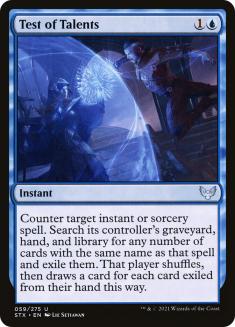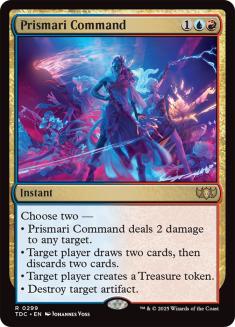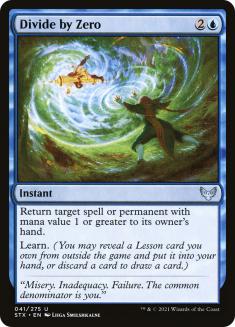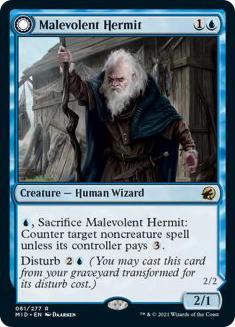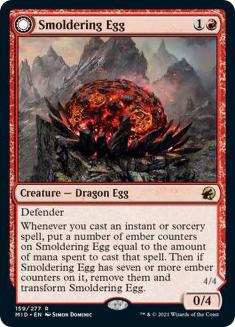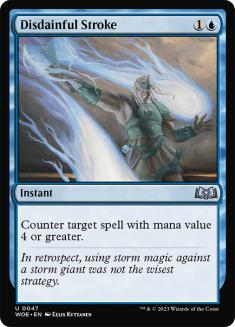Alrund’s Epiphany just might ruin Innistrad: Midnight Hunt Standard. Now I know I said the same thing three weeks ago in my article titled “Fateful Absence Just Might Ruin Innistrad: Midnight Hunt Standard“, so I understand if you’re skeptical. It’s just that before I was a fool spouting foolish claims about a white card. Today I’m talking about a blue card, which is a totally different story.
Now don’t sit there and think this public service announcement brings me any sort of joy. When Standard rotated, I was excited to start playing with midrange piles full of Briarbridge Trackers and Blood on the Snow. The last thing in the world I wanted was some Izzet Taking Turns deck to be the best thing to be doing. I mean come on, haven’t we had enough of that already with Nexus of Fate?!
That’s the reality we’re in though, Izzet Epiphany may very well be the best deck in the format, and at the very least it will be the format’s most influential deck dictating what can and cannot be played. No longer is it justifiable to play these “go-over-the-top” midrange decks designed to sit on top of other Esika’s Chariot / Wrenn and Seven strategies as they just get slaughtered by the ultimate combo/control Izzet Turrns deck.
Lands (22)
Spells (38)

So enough “the sky is falling” talk — let’s get down to business. Last weekend the archetype started popping up in a variety of tournaments and in social media posts. Just like with every new archetype, the lists were all over the place. Some just played Izzet Dragons with four copies of both Goldspan Dragon and Smoldering Egg. Others just played Smoldering Egg or no creatures at all, and everyone disagreed on which removal should be played in the deck.
There was one thing everyone agreed on, however.
This is the heart and soul of the strategy. Simply put, you foretell an Alrund’s Epiphany at some point in the early- or mid-game. After that you get to eight mana, cast Galvanic Iteration, then your Alrund’s Epiphany. This gives you two extra turns to cast more copies of Alrund’s Epiphany, cast your draw spells to find more copies of Alrund’s Epiphany, or simply attack them with your Birds and creature-lands.
It only took me a couple of matches with whatever list I pulled off the internet to realize this deck is disgusting. I then took a step back to start thinking about the future of the archetype, as it doesn’t take a prophet to realize that excessive hate was soon to be coming for the deck. To survive, other decks would clearly need to splash counterspells, play excessive amounts of interaction, or simply get very lean and aggressive. I didn’t know if any of those things would actually be effective, especially after I pre-prepared for them.
Lands (9)
Spells (51)

**WARNING**
This decklist is not complete. I mean, of course it’s 75 cards, but it’s still a work in progress. Innistrad: Midnight Hunt Standard is moving exceptionally quickly right now, which is making it difficult for me to pinpoint exactly what cards and quantities I’m looking for. It’s also a new archetype that has a lot of interesting card choices and decisions to make.
So instead of my more normal primer articles, today I’ll go over all my current card choices that I’ve made and explain why I’m making them. That should, at the very least, speed up the learning process and get you ready to crush this weekend’s SCG Tour Online Championship Qualifier!
First things first, I’m not playing any creatures maindeck. There are three reasons for this:
- You don’t need them to win the game.
- Opponents have maindeck removal that interacts with them.
- They don’t synergize with Galvanic Iteration.
All three points are important, but the last one is what transforms this deck from good to great. Galvanic Iteration is an exceptionally powerful Magic card, and doesn’t just have to be seen as a combo piece. You can pair it with removal spells, card draw spells, and even sweepers if you’re playing the right ones.
I was convinced that Battle of Frost and Fire was the superior sweeper in this deck until Eric Froehlich opened my eyes to Burn Down the House. Battle of Frost and Fire just seemed great at cleaning up the battlefield, scrying into a seventh land, and then setting up a great couple of turns of casting Alrund’s Epiphany. The only issue with Battle of Frost and Fire is that it doesn’t combo with Galvanic Iteration.
Burn Down the House, however, does combo with Galvanic Iteration in addition to doing some nutty things in this deck thanks to having two modes of play. As a sweeper it can deal with things that Battle of Frost and Fire can’t, such as a Wrenn and Six plus token on five lands. I know the window seems small, but this does come up a reasonable amount of time. Sometimes those tokens will grow, which Burn Down the House has the ability to deal with when paired with Galvanic Iteration, another thing Battle of Frost and Fire isn’t capable of.
What really sets the two apart though is what Burn Down the House can do when comboing off. One of the cleaner sequences is when you get to eight mana and cast Galvanic Iteration into Alrund’s Epiphany. This sets you up for two extra turns and two attack steps. Now on the next turn’s first main phase, you can flash back Galvanic Iteration and cast Burn Down the House, creating six Devil tokens with haste. Now you’ve got ten tokens attacking for two turns, which totals what again?

That’s just some good ole clean living if you ask me!
Memory Deluge is another card that initially got a ton of spotlight in this archetype, but doesn’t work favorably with Galvanic Iteration. That’s because Memory Deluge cares how much mana you dumped into it. If you copy a Memory Deluge with Galvanic Iteration, your copy will get to look at a whopping zero cards! It’s not like this is the end of the world or anything, but is something to consider when building the deck (especially when a card like Behold the Multiverse synergizes exceptionally well with the two-mana Fork).
Speaking of Behold the Multiverse, it has been exceptional for me. It’s another thing we can dump our mana into on Turn 2 and then cast for cheap later in the game. This allows us to combo it with Galvanic Iteration or just interact with the opponent on the same turn we dig into our decks for our other combo pieces.
I really don’t know what numbers you should be playing of these three card-advantage spells, but at the end of the day it feels like a random assortment will always be better than just running four copies of two of them. Test of Talents is already a serious threat to this deck so you really don’t want to open yourself up to getting a large swath of your card-advantage spells removed from your deck in the early turns. Still, I may look back and laugh at myself for not playing four Expressive Iteration, a card we always have maxed out on. Shrug.
Spikefield Hazard is going to become a necessity moving forward. So many decks, including Izzet Epiphany, are playing Malevolent Hermit in the sideboard to combat other blue matchups. This two-drop poses problems on multiple fronts as a great way to get early damage in, but also protect future spells from being counters in the late-game. Spikefield Hazard is the perfect answer thanks to exiling the annoying sideboard cards before things get too far out of hand.
Now obviously this card isn’t doing us many favors when it comes to our manabase. It alongside Jwari Disruption can sometimes cause us to have awkward mana, but that does get mitigated thanks to the sheer number of lands the deck should be playing. That way we have enough options to sequence things correctly. I’m not sure if the number should be 28, 29, or 30, but I’m confident that it’s in that ballpark.
Previous lists of Izzet Epiphany focused a lot of their interaction on Fading Hope and Cathartic Pyre. Both are decent, but are still just generic interactive spells. Fading Hope can help with larger Treefolk tokens as well as creature-lands, but more often than not are getting sideboarded out for better removal spells (especially when interaction comes in making tempo-based spells like it a huge liability in longer games).
The change to Burning Hands maindeck might seem like an overcorrection towards Mono-Green Aggro❄’s increase in popularity, but that’s only half the story. I believe Izzet Epiphany will become the most popular deck going into this weekend, a (mirror) matchup that invalidates our maindeck removal spells. Dimir Control is also a deck that might be able to compete with Izzet Epiphany that also doesn’t merit creature interaction.
If all of this plays out the way I think it will, we might as well just play the best removal spells for the decks that do have creatures, and Mono-Green Aggro❄ is the most popular. It also doesn’t hurt that there are still other green-based decks roaming the lands that Burning Hands is good against.
I still want access to Cathartic Pyre, because Werewolves like Reckless Stormseeker exist and need to be dealt with. I don’t think this is the most pressing issue we currently have, but I could see a world where decks start leaning on creatures like it and Goldspan Dragon that can’t die to Burning Hands. It’s one of the main reasons for including Thundering Rebuke in the sideboard, as Gruul Aggro and Izzet Dragons still exist. Sometimes you have to deal four damage, you know?
Now we get to what I find to be the most interesting part of the deck — playing around Test of Talents. This is by far the scariest counterspell one could cast against us, because if it resolves on our first Alrund’s Epiphany, we may find it very difficult to actually win the game even if we got to take an extra turn thanks to Galvanic Iteration. It’s one of the reasons why I have two Smoldering Eggs in the sideboard so we at least have a decent Plan B when these situations arise.
Luckily for us, Alrund’s Epiphany is a messed-up card. Well maybe I should just say, “Foretell is an interesting mechanic.” Sometimes we’ll be up against hyper-aggressive decks splashing Test of Talents and simply lose games where we had to go for it and they had it. Other times, against other blue decks, we’re going to want to play extremely slow games spending our time stockpiling on foretold copies of Alrund’s Epiphany. That way, if one does get countered by Test of Talents, we have a couple more waiting in the wings to help us get over the finish line.
I’m usually not one for blue mirrors, but I’ve actually been enjoying them when playing this deck. There are just so many interesting things going on all at the same time. Sure, some of the age-old things are happening, like the importance of developing your land count and making sure you keep casting draw spells into more draw spells. There’s tension there for sure, but while that’s going on you also have to account for opposing copies of Malevolent Hermit or other transitional threats your opponent may have. Oh, and also when to use your copies of Divide by Zero, as they’re a great way to interact with uncounterable spells, copies of spells, and spells that are being cast via flashback.

I’m pretty sure I’ll get sick of it after a while, but for now I’m rather enjoying the blue-on-blue life!
The last card I’ll talk about is the latest addition to my list, and most likely to get cut. Quite honestly, I’m just trying Prismari Command out and for now things look promising. It’s a great way to interact with an Esika’s Chariot, but your deck already has many of those. It’s also a nice way to accelerate into combo turns or kill a Benevolent Geist that found its way onto the battlefield. Still, it’s not the most impressive card and actively bad in multiples. I may settle on one or two copies, but it could very well be a mistake to play.
So like I said earlier, today’s list is still a work in progress. I keep trying new cards and new sideboard plans. While it’s great for me that I once again find enjoyment in Standard, it does mean I don’t have a concrete sideboard guide for you today. I’ll still leave you with my sideboarding notes, but please take them with a grain of salt.
VS Izzet Epiphany, Izzet Dragons, Dimir Control, and Azorius Control
Out:
In
Bring Thundering Rebuke in against Izzet Dragons.
VS Mono-Green Aggro❄ and Gruul Aggro
Out:
In:
Bring Smoldering Egg in if you see mana that indicates a blue splash.
VS Gruul Werewolves
Out:
In:


